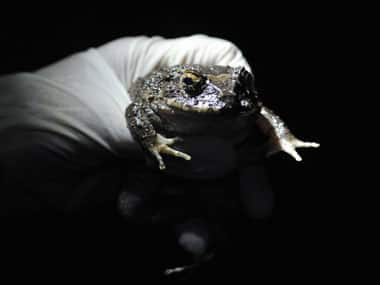Thiruvananthapuram: As part of conservation of endangered animal species especially amphibians, the National Biodiversity Congress has sought a ban on using animals covered under the Wildlife Protection Act for study and experimental purposes. Many species of amphibians, listed as protected in the Wildlife Act, are facing extinction on the global scale due to man-made causes, NBC’s consolidated recommendations’ report said. [caption id=“attachment_876407” align=“alignleft” width=“380”]  Agencies[/caption] “Use of frogs as tools to understand basic concepts in Biology and Pharmacology has been going unabated, in spite of the warnings from Ministry of Environment and Forest and UGC,” said the report drawn up recently based on the first National Biodiversity Congress held here in November last. “There is an urgent need to sensitise the teachers against this practice and help conservation of the frog species, by approaching the issue from curricular,pedagogical, ecological, legal and ethical perspectives, and encourage use of digital and simulation alternatives for understanding of the respective academics,” the report said. Frogs belonging to the genus Rana are included in Schedule IV, which means that these frogs should not be removed from the natural habitats without permission from competent authorities. University Grants Commission, in recent guidelines to phase out animal dissections from Zoology and Life Science curriculum, has put a blanket ban on using animals covered under Wildlife Protection Act for dissections and experiments by the intervention of Bharatidasan University at Tiruchirapalli in Tamil Nadu. The university has developed an alternative technology for the purpose to avoid frogs being dissected in college labs. Frogs under the genus Rana, already threatened and included in the International Union for Conservation of Nature (IUCN) Red List, cannot at all be used in dissection and experiments. Noted environmentalist and conservationist with Department of Environmental Biology, University of Delhi, SD Biju, hailed the decision to ban the use of wild animals, especially amphibians, for routine classroom teaching. “There are a lot of modern ways to teach internal anatomy of animals using models that are now very common in many countries,” Biju told PTI. Amphibians are the most threatened animals not only in India but all over the world. Almost 60 percentage of amphibians are facing extinction because of various reasons, mostly habitat destruction and alteration, he said. In India, thousands of frogs are being collected from the wild every day for classroom dissection.“Frog dissections are unethical and unnecessary.They contribute to the depletion of wild frog populations and the spread of harmful invasive species and infectious diseases,” he said. “Frogs are an important part of the ecosystem. Maintaining the food chain, environmental health and pest control are among their many direct and indirect benefits to the world,” he added. The NBC report also expressed serious concern over the threat of extinction faced by marine turtles mainly due to degradation of nesting sites along Kerala coast. The report identified beach erosion caused by sand mining and coastal afforestation as major causes for the destruction of nesting sites of turtles. Building awareness on marine turtle conservation, enforcing regulations against illegal sale and consumption of turtle meat and eggs, and better vigilance for beach sand mining and illegal trawling are needed to conserve marine biodiversity, it said. PTI
As part of conservation of endangered animal species especially amphibians, the National Biodiversity Congress has sought a ban on using animals covered under the Wildlife Protection Act for study and experimental purposes
Advertisement
End of Article
Written by FP Archives
see more


)

)
)
)
)
)
)
)
)



